Georg Sauter
Georg Sauter (20. April 1866 – 20. December 1937) was a German-English painter, lithographer and draftsman.[1]
Georg Sauter | |
|---|---|
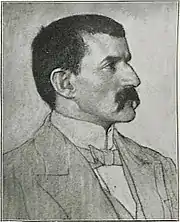 Georg Sauter by William Strang | |
| Born | 20 April 1866 |
| Died | 20 December 1937 (aged 71) |
| Nationality | German |
| Education | Academy of Fine Arts, Munich |
| Known for | portrait, landscapes |
| Movement | London |
| Spouse(s) | Lilian Galsworthy; Valda Broad |
Life
In 1880 Georg Sauter began training as a house painter and then worked in Munich with a painter master. Later he took drawing lessons. He studied painting from October 1884 in the antic class of the Royal Academy of Fine Arts in Munich.[2] There he was a pupil of the landscape painter Ludwig von Löfftz (1845-1910) and received also suggestions by the portrait painter Franz von Lenbach (1836-1904).
Georg Sauter undertook study trips to Holland, Belgium, France and Italy, then lived in London from 1889 as a painter and lithographer, where he married in 1894 Lilian Galsworthy (1864–1924), the sister of the English novelist John Galsworthy. Sauter entered a circle of artists that included the painters Hubert Herkomer, John Lavery and George Frederick Watts, the author Joseph Conrad and the poet John Masefield.[3] He also met the American painters Joseph Pennell and James Abbott McNeill Whistler, both of whom became close friends.[3] His works show the influence of James Whistler. His painting "The Bridal Morning", issued in 1909, won second prize in the Carnegie Art Institute's annual exhibition in Pittsburgh, Pennsylvania, but became the cause of a scandal over its erotic mood.[4]
With the beginning of World War I Sauter was, despite married to an Englishwoman, interned as an enemy alien in 1916 at Alexandra Palace and later expelled.[5] First he went to Jena. Here he had support from the families of glass industrialist Otto Schott and his son-in-law Heinrich Gerland, lawyer and professor at the University of Jena. The friendship with the Gerlands arose in 1906, when Gerland, accompanied by his wife Eva, made a study trip to England and met the artist there. Sauter produced a series of portraits for the Schott family. At the recommendation of Gerland, Sauter created a series of 30 professorial portraits for the University of Jena between 1922 and 1923, which he executed as charcoal drawings. For his work Georg Sauter was appointed honorary citizen of the University of Jena in 1936.
Sauter had his residence in Rome at the beginning of the 1930s. During a stay in Cologne in 1930/31 Sauter portrayed the mayor of Cologne Konrad Adenauer and his second wife Gussi. Adenauer then recommended him to other acquaintances, including the industrialist Carl Duisberg: "He draws heads of men who interest him and combines these drawings into a collection.".[6] Back in Germany, Sauter settled in 1933 in the artists' colony Brannenburg.
In 1898 Sauter was one of the founders and member of council of the International Society of Sculptors, Painters and Gravers.[3] He was also a corresponding member of the Vienna Secession and the Société Royale des Beaux Arts in Brussels[7] and a member of the Deutscher Künstlerbund (Association of German Artists).[8]
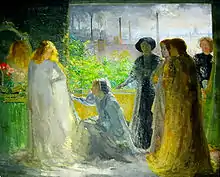
Georg Sauter was secondly married to Valda Broad (died Dec. 1937) since 1926. The son Rudolf Sauter (1895-1971) was also a portrait painter, draftsman and graphic artist. Among other things, he illustrated the works of his uncle John Galsworthy.
Industry, too, has inspired George Sauter to one of his finest works "The Leeds Picture", which forms part of the Wilson collection. This canvas, very different in subject from those he is best known by, symbolises the homage of Labour to Beauty, to whom the products of local industry are offered by attendant females, and is certainly one of the most harmonious and complete pictures that the artist has produced.
— Abel Torcy, "Modern Art in Leeds: The Collection of Mr. Sam Wilson", The Studio: international art. 69.1916.[9]
Honors
- Commander of the Order of Francis Joseph, Austria
- Knight of the Order of St Michael, 4th Class, Bavaria
- Knight of the Order of the Zähringer Lion, Baden
- Honorary citizen of the Friedrich Schiller University, Jena
- Holder of various gold medals from international exhibitions
- Royal Bavarian professor, 1902
- Silver Medal and Thousand Dollar Prize of the Carnegie Museums of Pittsburgh, 1908[7]
Gallery
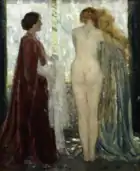 The Bridal Morning, 1902
The Bridal Morning, 1902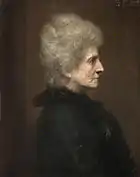 Blanche Bailey Galsworthy
Blanche Bailey Galsworthy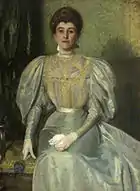 Ada Galsworthy
Ada Galsworthy John Galsworthy
John Galsworthy_Lilian_Sauter.jpg.webp) Lilian Sauter
Lilian Sauter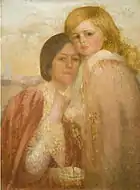 Maternity, 1899[10]
Maternity, 1899[10]
Further reading
- Ulrich Thieme, Felix Becker at all (1935). Allgemeines Lexikon der Bildenden Künstler von der Antike bis zur Gegenwart (in German). Vol. 29. E. A. Seemann, Leipzig. p. 496.
- Hans Vollmer at all (1958). Allgemeines Lexikon der bildenden Künstler des XX. Jahrhunderts (in German). Vol. 4. E. A. Seemann, Leipzig. p. 164.
- Stalla, Bernhard Josef (2011). Lebenswege eines Malers und Zeichners: Georg Sauter (in German). Verlag Peter Drexler, Brannenburg. ISBN 978-3-00-035059-7.
- Dearinger, David B. (2004). Paintings & Sculpture at the National Academy of Design. Vol. 1 (1826-1925). Hudson Hills, New York. p. 491. ISBN 9781555950293.
- von Térey, Gabriel (1907). "George Sauter". Die Kunst für alle: Malerei, Plastik, Graphik, Architektur (in German). Vol. 22 no. 11. pp. 248–259. Retrieved 2018-04-03.
- Schäfer, Peter (2008). "Georg Sauter und seine Jenaer Professorenporträts" [Georg Sauter and his professorial portraits] (in German). Verlag Vopelius. Retrieved 2018-04-03.
External links
| Wikimedia Commons has media related to Georg Sauter. |
- "Biography of George Sauter" – Glasgow University: The Correspondence of James McNeill Whistler.
- Uni-Journal Jena (2008). "Ein Maler zu Gast bei der Familie Schott" [A painter guest at the Schott family] (in German). Universität Jena. Retrieved 2018-04-03.
- Some works from Georg Sauter at Art-UK – Discover Artworks
- Sauter, George (1898). "The International Society of Painters, Sculptors and Gravers". The Studio: An Illustrated Magazine of Fine and Applied Art. Vol. 14 no. 64. The Studio, London. pp. 109–120. doi:10.11588/diglit.21969.23.
References
- "Zeittafel (Timetable)." Neue Künstlerkolonie Brannenburg (in German). Archived from the original on 21. December 2015 at archive.is
- "00056 Georg Sauter", Matrikelbuch 1884–1920, Academy of Fine Arts, Munich
- Dearinger, David B. (2004). Paintings & Sculpture at the Nat. Academy of Design. Vol. 1 (1826-1925). Hudson Hills. p. 491. ISBN 9781555950293.
- Boime, Albert (1970). "Georg Sauter and the Bridal Morning" (PDF). American Art Journal, New York. pp. 72–80. Retrieved 2018-04-03.
- Webb, Simon (2016). British Concentration Camps: A Brief History from 1900-1975. Pen and Sword. pp. 50–51. ISBN 978-1473846326.
- Schäfer, Peter (2008). "Georg Sauter und seine Kölner Adenauer-Porträts" [Georg Sauter and his Cologne Adenauer portraits]. Geschichte in Köln. Geschichte in Köln. vol. 55, nr. 1 (Dec. 2008) (in German). de Gruyter online. 55: 245. doi:10.7788/gik.2008.55.1.245. S2CID 183608502.
- "Sauter, Prof. George." in "Who Was Who ?" – (Oxford Index)
- "kuenstlerbund.de: Ordinary members of the Deutscher Künstlerbund since its foundation in 1903 / Sauter, Georg". Archived from the original on 2016-03-04. Retrieved 2018-04-03.
- Torcy, Abel (1916). "Modern Art in Leeds: The Collection of Mr. Sam Wilson". The Studio: An Illustrated Magazine of Fine and Applied Art. Vol. 69 no. 285. The Studio, London. p. 111. doi:10.11588/diglit.24575#0121.
Today the picture is at the Leeds Art Gallery (see here). - This painting is a half-length portrait of (Blanche) Lilian Sauter and (her son) Rudolf Sauter as a child. Informations by Art-UK